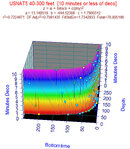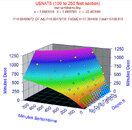Yes agreed - its your thread - lets go with that. ...
Maybe more like a continuation thread where we stick to nuts and bolts. First and foremost, I'm not a decompression expert by any stretch of the imagination. Second, I don't do "big" dives. Third, I do dive deco and want to know as much as I can about this fuzzy subject.
As for your permission, Thanks. I'll stay away from anything that looks like how you implemented VPM-B, most likely that will come out if I start making any progress. I'll keep that to myself. I'm only interested in how VPM-B (with no corrections, i.e. conservatism) compares to a standard. The only standard that I have access to is the US Navy Air Table 5. That is clearly an apples and oranges problem but maybe something can be teased out. A big problem too, as that table is highly nonlinear (with respect to deco) in both depth and bottom time. See first two graphs. -extremely hard to get a general "feel' for it.
... But we need to define some terms and objectives.
What is the "required" level of deco? Does a model represent that?
How much margin has been added to each model, and can it be removed to come to a common base line? ...
The required level of deco, the common baseline, for this initial approximation would be the USNAT5. Now if you had similar human tests for VPM-B over the same range none of these epic threads would exist.
... A great deal of a models margin for safety is the hands of the designer, and how he feel or chooses to implement that. How are you going to account and equalize that? ...
I would be happy to start with a graph that shows the deviation between VPM-B and USNAT5 that covers whatever range that you guys are stressing over. Exactly how to show that deviation is most problematic.
Adding conservatism could be done by scaling the fitting equation, scaling the deco requirement (or depth or bottom time) and re-fitting an equation to that. Whatever seems to work best. Don't know.
... How do you propose to compare shallow and deep? There is no tool to do this with so far. The dive procedure is where the DCS injury starts. Clearly the differences with in-dive stress levels are significant. If the compare method does not give value to that aspect, then it becomes just another one side biased to the shallow attack. ...
That is the problem, isn't it? Thus my earlier attempt to put a number to the "bigness" of a dive, think of it as multiplying in an "exposure" value of some sort. Still working on that. Any guidance on this would be most appreciated.
... What about different run times for the same dive? I hope we not assuming that all dives are somehow, magically made equal by using the same end run times? ...
Bubble theory is all about getting out of the water sooner and without harm. Forcing the runtimes to be the same is much like throwing the baby out with the bathwater.
... If it were the navy, it would be a pDCS measure, but they only have data on their own kind of shallow stop based dives - no deep(er) stop data there. ...
That is a fundamental problem, but it is a place to start. Bubble theory, IMHO, has to follow dissolved gas theory up to a point and then it would be expected to begin asserting itself ever stronger with depth and time.
One could construct a VPM-B table and compare it to the Navy Table. The two tables will be more and more different with increasing depth and bottom time. Can you save me an awful lot of work and offer your opinion as to where bubble theory begins to assert itself?
And now for the big question, is there a statistically sound collection of deep dives that support bubble theory of any sort? Not trying to be a pain, but the question has to be asked.
-Thanks.











